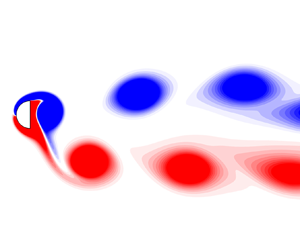No CrossRef data available.
Published online by Cambridge University Press: 06 May 2022

This paper presents the response and the wake modes of a freely vibrating D-section prism with varying angles of attack ( $\alpha = 0^\circ \text {--}180^\circ$) and reduced velocity (
$\alpha = 0^\circ \text {--}180^\circ$) and reduced velocity ( $U^* = 2\text {--}20$) by a numerical investigation. The Reynolds number, based on the effective diameter, is fixed at 100. The vibration of the prism is allowed only in the transverse direction. We found six types of response with increasing angle of attack: typical vortex-induced vibration (VIV) at
$U^* = 2\text {--}20$) by a numerical investigation. The Reynolds number, based on the effective diameter, is fixed at 100. The vibration of the prism is allowed only in the transverse direction. We found six types of response with increasing angle of attack: typical vortex-induced vibration (VIV) at  $\alpha = 0^\circ \text {--}35^\circ$; extended VIV at
$\alpha = 0^\circ \text {--}35^\circ$; extended VIV at  $\alpha = 40^\circ \text {--}65^\circ$; combined VIV and galloping at
$\alpha = 40^\circ \text {--}65^\circ$; combined VIV and galloping at  $\alpha = 70^\circ \text {--}80^\circ$; narrowed VIV at
$\alpha = 70^\circ \text {--}80^\circ$; narrowed VIV at  $\alpha = 85^\circ \text {--}150^\circ$; transition response, from narrowed VIV to pure galloping, at
$\alpha = 85^\circ \text {--}150^\circ$; transition response, from narrowed VIV to pure galloping, at  $\alpha = 155^\circ \text {--}160^\circ$; and pure galloping at
$\alpha = 155^\circ \text {--}160^\circ$; and pure galloping at  $\alpha = 165^\circ \text {--}180^\circ$. The typical and narrowed VIVs are characterized by linearly increasing normalized vibration frequency with increasing
$\alpha = 165^\circ \text {--}180^\circ$. The typical and narrowed VIVs are characterized by linearly increasing normalized vibration frequency with increasing  $U^*$, which is attributed to the stationary separation points of the boundary layer. On the other hand, in the extended VIV, the vortex shedding frequency matches the natural frequency in a large
$U^*$, which is attributed to the stationary separation points of the boundary layer. On the other hand, in the extended VIV, the vortex shedding frequency matches the natural frequency in a large  $U^*$ range with increasing
$U^*$ range with increasing  $\alpha$ generally. The galloping is characterized by monotonically increasing amplitude with enlarging
$\alpha$ generally. The galloping is characterized by monotonically increasing amplitude with enlarging  $U^*$, with the largest amplitude being
$U^*$, with the largest amplitude being  $A^* = 3.2$. For the combined VIV and galloping, the vibration amplitude is marginal in the VIV branch while it significantly increases with
$A^* = 3.2$. For the combined VIV and galloping, the vibration amplitude is marginal in the VIV branch while it significantly increases with  $U^*$ in the galloping branch. In the transition from narrowed VIV to pure galloping, the vibration frequency shows a galloping-like feature, but the amplitude does not monotonically increase with increasing
$U^*$ in the galloping branch. In the transition from narrowed VIV to pure galloping, the vibration frequency shows a galloping-like feature, but the amplitude does not monotonically increase with increasing  $U^*$. Moreover, a partition of the wake modes in the
$U^*$. Moreover, a partition of the wake modes in the  $U^*$–
$U^*$– $\alpha$ parametric plane is presented, and the flow physics is elucidated through time variations of the displacement, drag and lift coefficients and vortex dynamics. The angle-of-attack range of galloping is largely predicted by performing a quasi-steady analysis of the galloping instability. Finally, the effects of
$\alpha$ parametric plane is presented, and the flow physics is elucidated through time variations of the displacement, drag and lift coefficients and vortex dynamics. The angle-of-attack range of galloping is largely predicted by performing a quasi-steady analysis of the galloping instability. Finally, the effects of  $m^*$ and
$m^*$ and  ${\textit {Re}}$, the roles of afterbody and the roles of separation point in determining vibration responses and vortex shedding frequency are further discussed.
${\textit {Re}}$, the roles of afterbody and the roles of separation point in determining vibration responses and vortex shedding frequency are further discussed.